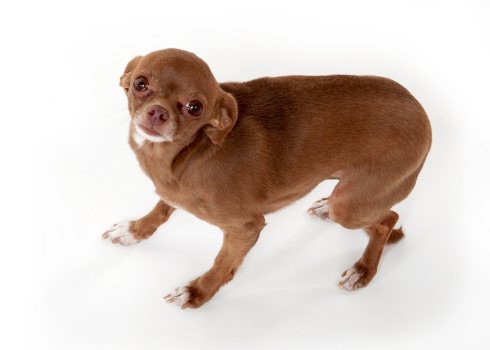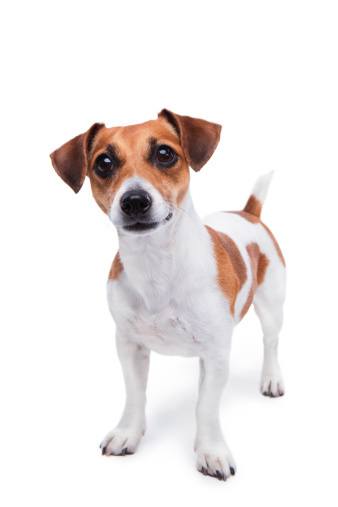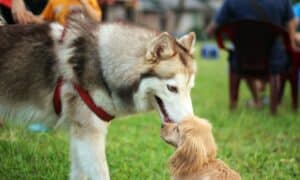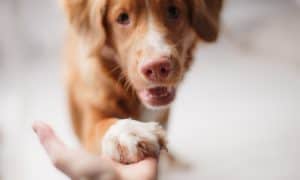“This post contains affiliate links, and I will be compensated if you make a purchase after clicking on my links.”

Did you know that dogs, like humans, share a universal body language? This awe-inspiring way of communication is one that we humans can also understand. By learning their unique language, we can connect and communicate with our pooches far more effectively.
Uncovering the Meaning of Your Dog’s Postures
For the first in a three-part series, let’s take a look at dog’s postures and what they can mean:
1. The relaxed stance. This is often shown with his ears up yet relaxed (not forward) and his tail down. A relaxed pooch may even have his mouth somewhat opened with the tongue slightly exposed.
2. The play stance. This is usually indicated by your dog’s front end brought down and his back side held up. His tail may be upright and is usually wagging. The dog’s ears may also be erect and his mouth slightly opened with the tongue showing.

3. The submissive stance. Submission is most obvious when the dog lies on his back or on his side as he raises his legs to expose the throat and belly. He might avoid eye contact while his tail is seen between his legs, not to be mistaken as fear. The corners of his mouth as well as his ears and hair will be drawn down and back.
4. The scared stance. This is easily identified when the dog refuses to look at you directly for a long time. To make himself small and appear unimposing, his body will be lowered with the ears back, corners of the mouth pulled back, and the tail down. The dog may even lick you and try to raise a paw.
5. The alert stance. This is normally signified with the ears up and forward, mouth closed, and the tail straightened out, though not stiffened. The dog’s legs may be tensed as he leans slightly frontward. Fido may also be seen raising and then lowering his head.
6. The defensive stance. This is readily recognized when the dog’s body is lowered with the ears pulled back and the tail in between his legs. Their hair might stand on end, indicating his leaning to aggression in an effort to protect himself.
7. The aggressive stance. This is commonly shown by the prickling hair most obvious in the dog’s shoulder area and the tail upstretched. Fido’s nose may be wrinkled and his teeth bared. His ears will also be high and forward, with the stance going a little frontward. Barking and growling may even be observed. Never approach this dog and try to turn away as eye contact can be misread as threat.
Understanding your dog’s posture is an excellent way of gauging what he’s trying to communicate, especially when combined with an understanding of the language of a dog’s tail and head. Come back tomorrow for Part Two: Your Dog’s Tail, followed by Part Three: Your Dog’s Head.



















R Jackson
Oct 18, 2013 at 4:33 pm
My chihuahua does that, too. I reach, he backs up. I reach further, he backs up more. To remedy, I leave my hands where they are when I first reach out and he backs up. Then I tell him that he has to meet me half way. After that, he comes fairly quickly when he figures out that while the back-up waltz is over, he’s welcome in my arms!
Jenn
Oct 18, 2013 at 2:40 pm
Vickie, that is a typical trait of shelties. Many herding breeds and most toy dogs will respond that way. My own Chinese Crested’s do the pet me dance and then back away. It helps to bend your knees when you lower yourself to pet them, that way you are not towering over top of them, which is dominate and aggressive. Even a dominate sheltie is fairly timid, as dogs go, and would rather be the one to start an interaction. With my dogs, if they want to be pet or play, I sit down, and they happily approach.
Vickie B.
Aug 6, 2013 at 1:46 pm
We have a female sheltie that is VERY independent, and definitely the alpha dog. For some reason, and we don’t know why, she will come up to you but then when you reach down to pet her, she backs up. Also, she licks us a LOT. I just thought it was when she wanted to go outside. Does anyone have any idea why she backs up the way she does, and will not let you pet her, or even sometimes go near her? We have had her since she was a pup, and we have never, ever hit, kicked, etc. her.
Dee
Oct 19, 2013 at 6:11 pm
We have a little Chi that is the same way. He has never been mistreated yet he won’t allow us to reach down to pet him (backs away), or pick him up. If we force him to let us pick him up, he will cower. He will come to us however if we’re sitting on the couch or chair and jump in our laps and lick us to death. He’s not afraid of us.. I don’t know how he could be as he’s never seen a harsh hand. Although I dislike the situation, he’s our little angel and it’s good to know that there’s other dogs out there that have the same actions; I thought we were the only ones! LOL
Jilana Ordman
Oct 19, 2013 at 6:18 pm
My chihuahua does the same thing. He just likes to be the one taking the lead in the interaction. As long as yours will always come when you call him, sit when you command it, and let you pick him up from a sit, I don’t think its a big deal. I’ve just figured that mine thought the world was big and scary, and was trying to claim some personal authority in the face of overwhelming size differences!
Liz
Aug 6, 2013 at 10:53 am
I have to agree with Shauna…my bitch will raise her hackles, almost any time she first meets a new dog. She never growls, or bares teeth just raises her hackles until she can get a good sniff of the new dog.
Shauna D
Aug 3, 2013 at 9:56 am
Whom ever wrote this article needs to do more research into raised hackles???There are other reasons why a dog has raised hackles that has nothing to do with aggression. A dog’s hackles can be raised for a number of reasons in just a matter of seconds. Fear, excitement, interest, aggression, nervousness, insecurity, startled or aroused feelings can cause a dog’s hair to bristle. Sounds, scents or direct encounters with other dogs and stressful situations can put the dog on guard. Understanding a dog’s body language isn’t difficult to comprehend and it’s essential for dog owners to take the time to learn what a dog is trying to say so you can grasp what his intentions or concerns are and recognize his state of mind
Anne Cooney
Aug 2, 2013 at 4:29 pm
What about the “Assertive Stance”? My shetland sheepdog was identified by her breeder to be “an alpha female”. This is not the same as “agressive” female – far from it. She stands alert,tail up as she allows other dogs to approach and sniff. If they get out of line, she warns with them with the curl of her right lip, if they continue to get out of line, she displays a full lip curl. One more inappropriate move and the impolite pup is put in place with a growl and a non-connecting snap. I have never seen another dog challenge her quiet and assertive authority.